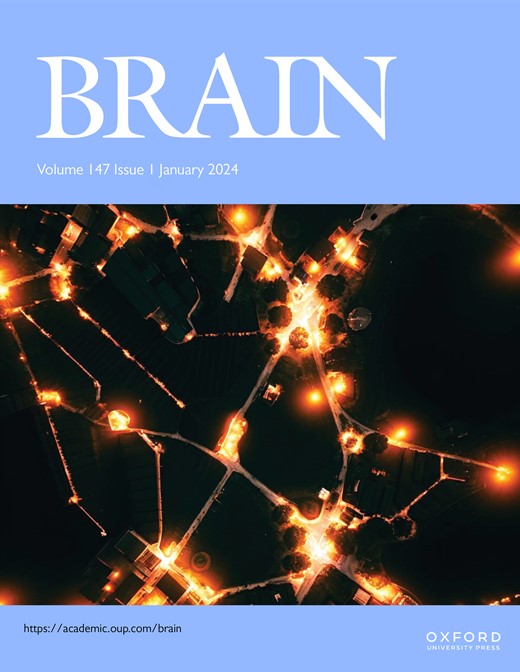雷丙地尔对glun2b - n -甲基-d-天冬氨酸受体的抑制作用
IF 11.7
1区 医学
Q1 CLINICAL NEUROLOGY
引用次数: 0
摘要
n -甲基- d -天冬氨酸受体介导大脑兴奋性突触传递中缓慢的Ca2+渗透性组分,并参与神经元发育和突触可塑性。大多数NMDA受体是由五个基因(GRIN1, GRIN2A-D)编码的两个GluN1和两个GluN2亚基的四聚体组合,产生GluN1和GluN2A-D亚基。含有GluN2B亚基的NMDA受体具有独特的药理学性质,可被多种结构不同的联芳基化合物抑制,具有高效和选择性。考虑到含有glun2b的NMDA受体在正常脑功能和病理情况下发挥的众多作用,这些药物具有相当大的治疗价值。在GluN2B选择性阴性变构调节剂中,雷地尔对含有GluN2B的NMDA受体具有高效性和选择性,并且在人体中似乎是安全的。在这里,我们通过x射线晶体学评估了radiprodil与异二聚体GluN1-GluN2B氨基末端结构域结合的结构决定因素,并探讨了抑制的分子机制。在患有各种神经和神经精神疾病(包括自闭症、智力残疾、癫痫、语言障碍和运动障碍)的患者中,已经发现了大量GRIN基因家族的新生变异。我们发现,在体外测试的80%以上的人类疾病相关的GRIN1和GRIN2B错义变异(22/27,与WT受体同等或更有效)中,radiprodil是一种有效的拮抗剂,包括孔形成区、连接区和其他地方的变异,这些变异均匀地增加了NMDA受体介导的电荷转移。我们发现,在从敲入小鼠系急性分离的脑切片中,radiprodil阻断突触GluN2B受体,该小鼠系含有与早发性癫痫性脑病和顽固性癫痫患者相关的功能获得型GluN2B- ser810arg。此外,放射地尔对体内给药的化学惊厥药戊四唑有延迟癫痫发作的作用(458±90秒,对照药组为207±23秒)。这些数据支持glun2b选择性拮抗剂(如radiprodil)在神经系统疾病的临床治疗中的潜在效用,其中临床病因可能涉及含有glun2b的NMDA受体介导的电流增加。本文章由计算机程序翻译,如有差异,请以英文原文为准。
Inhibition of GluN2B-containing N-methyl-d-aspartate receptors by radiprodil.
N-methyl-D-aspartate receptors mediate a slow, Ca2+ permeable component of excitatory synaptic transmission in the brain and participate in neuronal development and synaptic plasticity. Most NMDA receptors are tetrameric assemblies of two GluN1 and two GluN2 subunits encoded by five genes (GRIN1, GRIN2A-D), which produce GluN1 and GluN2A-D subunits. NMDA receptors that contain the GluN2B subunit have unique pharmacological properties, being inhibited by multiple structurally distinct series of biaryl compounds with high potency and selectivity. These agents are of considerable therapeutic interest, given the numerous roles that GluN2B-containing NMDA receptors play in normal brain function and pathological situations. Among GluN2B-selective negative allosteric modulators, radiprodil inhibits NMDA receptors that contain GluN2B with high potency and selectivity and appears to be safe in human. Here, we evaluate the structural determinants of radiprodil binding to the heterodimeric GluN1-GluN2B amino terminal domain by X-ray crystallography and explore the molecular mechanism of inhibition. A large number of de novo variants have been identified in the GRIN gene family in patients with various neurological and neuropsychiatric conditions, including autism, intellectual disability, epilepsy, language disorders, and movement disorders. We show that radiprodil is an effective antagonist at over 80% of human disease-associated GRIN1 and GRIN2B missense variants tested in vitro (22/27, equally or more effective as WT receptors), including variants in the pore-forming region, linker regions, and elsewhere that uniformly increase NMDA receptor-mediated charge transfer. We show radiprodil blocks synaptic GluN2B receptors in brain slices acutely isolated from a knock-in mouse line harboring the gain-of-function variant GluN2B-Ser810Arg associated with early-onset epileptic encephalopathy and intractable seizures in patients. In addition, radiprodil delays the onset of seizures (458 ± 90 sec vs 207 ± 23 sec of vehicle group) in response to the in vivo administration of the chemoconvulsant pentylenetetrazole. These data support the potential utility of GluN2B-selective antagonists like radiprodil for clinical treatments of neurological conditions, where clinical etiologies may involve increased current mediated by GluN2B-containing NMDA receptors.
求助全文
通过发布文献求助,成功后即可免费获取论文全文。
去求助
来源期刊

Brain
医学-临床神经学
CiteScore
20.30
自引率
4.10%
发文量
458
审稿时长
3-6 weeks
期刊介绍:
Brain, a journal focused on clinical neurology and translational neuroscience, has been publishing landmark papers since 1878. The journal aims to expand its scope by including studies that shed light on disease mechanisms and conducting innovative clinical trials for brain disorders. With a wide range of topics covered, the Editorial Board represents the international readership and diverse coverage of the journal. Accepted articles are promptly posted online, typically within a few weeks of acceptance. As of 2022, Brain holds an impressive impact factor of 14.5, according to the Journal Citation Reports.
 求助内容:
求助内容: 应助结果提醒方式:
应助结果提醒方式:


